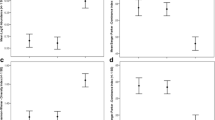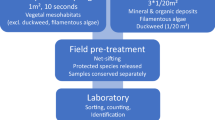Abstract
With the growing interest in small aquatic water bodies, especially as naturally replicated model systems for ecological research, aquatic invertebrate communities in phytotelmata are increasingly receiving attention these days. The recognition of the substantial contribution to the regional species pool of specialised species draws further attention to these small and often temporary habitats. The methods currently used for studying communities in some types of phytotelma, such as bromeliads, tend to be destructive, typically involving complete dissection of the plant. The expected increase in sampling intensity associated with the increasing interest in phytotelmata may result in a negative impact on plant populations in some areas, decreasing numbers in an unsustainable way, especially in locations with ongoing, intensive research. We therefore aimed to investigate whether less-destructive sampling methods can achieve sufficient data quality to allow their use as alternatives to complete plant dissection. We tested the effectiveness of three such methods in measuring the aquatic invertebrate communities in tank bromeliads (Tillandsia guatemalensis) in Cusuco National Park, Honduras. The three methods were pipetting the water out of the bromeliad, turning the bromeliad upside down and dissecting only the outer part of the plant (the oldest, often deteriorating leaves). Overall, we found that these methods were poor predictors of richness and abundance of the organisms in communities. However, we found big differences between taxonomic groups, depending in part on the ecology of the organisms, and we suggest that some less-destructive alternative methods may be appropriate for studying some specific groups (e.g. Culicidae). Based on these results and a rapid survey of the abundance of bromeliads in the national park, we question whether intensive, ongoing research into aquatic invertebrate communities in similar phytotelma populations is sustainable. From the point of view of conservation, alternative model systems need to be found.


Similar content being viewed by others
References
Araújo, V. A., S. K. Melo, A. P. A. Araújo, M. L. M. Gomes & M. A. A. Carneiro, 2007. Relationship between invertebrate fauna and bromeliad size. Brazilian Journal of Biology 67: 611–617.
Beaver, R. A., 1983. The communities living in Nepenthes pitcher plants: fauna and food webs. In Frank, J. H. & L. P. Lounibos (eds), Phytotelmata: Terrestrial Hosts for Aquatic Insect Communities. Plexus Publishing, New Jersey: 129–160.
Blaustein, L. & S. S. Schwartz, 2001. Why study ecology in temporary pools? Israel Journal of Zoology 47: 30–33.
Clarke, C. M. & R. L. Kitching, 1993. The metazoan foodwebs from six Bornean Nepenthes species. Ecological Entomology 18: 7–16.
De Meester, L., S. Declerck, R. Stoks, G. Louette, F. Van de Meutter, T. De Bie, E. Michels & L. Brendonck, 2005. Ponds and pools as model systems in conservation biology, ecology and evolutionary biology. Aquatic Conservation – Marine and Freshwater Ecosystems 15: 715–725.
Derraik, J. G. B., 2009. A tool for sampling mosquito larvae from phytotelmata. Journal of Vector Ecology 34: 155–156.
Frank, H., 1983. Bromeliad phytotelmata and their biota, especially mosquitoes. In Frank, J. H. & L. P. Lounibos (eds), Phytotelmata: Terrestrial Hosts for Aquatic Insect Communities. Plexus Publishing, New Jersey: 101–128.
Frank, H., S. Sreenivasan, P. J. Benshoff, M. A. Deyrup, G. B. Edwards, S. E. Halbert, A. B. Hamon, M. D. Lowman, E. L. Mockford, R. H. Scheffrahn, G. J. Steck, M. C. Thomas, T. J. Walker & W. C. Welbourn, 2004. Invertebrate animals extracted from native Tillandsia (Bromeliaceae) in Sarasota County, Florida. Florida Entomologist 87: 176–185.
Kitching, R. L., 1983. Community structure in water filled tree holes in Europe and Australia; comparisons and speculations. In Frank, J. H. & L. P. Lounibos (eds), Phytotelmata: Terrestrial Hosts for Aquatic Insect Communities. Plexus Publishing, New Jersey: 205–222.
Kitching, R. L., 2000. Food Webs and Container Habitats: The Natural History and Ecology of Phytotelmata. Cambridge University Press, New York.
Leroy, C., B. Corbara, A. Dejean & R. Céréghino, 2009. Ants mediate foliar structure and nitrogen acquisition in a tank bromeliad. New Phytologist 183: 1124–1133.
Lounibos, L. P., 1983. The mosquito community of treeholes in subtropical Florida. In Frank, J. H. & L. P. Lounibos (eds), Phytotelmata: Terrestrial Hosts for Aquatic Insect Communities. Plexus Publishing, New Jersey: 223–246.
Nastase, A. J., C. De La Rosa & S. J. Newell, 1991. A comparison of three methods for collecting dipteran insect larvae, which inhabit the northern pitcher plant (Sarracenia purpuracea). American Midland Naturalist 125: 356–359.
Richardson, B. A., C. Rogers & M. J. Richardson, 2000. Nutrients, diversity and community structure of two phytotelm systems in a lower montane forest, Puerto Rico. Ecological Entomology 25: 348–356.
Rotheray, G. E., E. G. Hancock & M. A. Marcos-Garcia, 2007. Neotropical Copestylum (Diptera, Syrphidae) breeding in bromeliads (Bromeliaceae) including 22 new species. Zoological Journal of the Linnean Society 150: 267–317.
Srivastava, D. S., J. Kolasa, J. Bengtsson, A. Gonzalez, S. P. Lawler, T. E. Miller, P. Munguia, T. Romanuk, D. C. Schneider & M. K. Trzcinski, 2004. Are natural microcosms useful model systems for ecology? Trends in Ecology and Evolution 19: 379–384.
Yanoviak, S. P. & O. M. Fincke, 2005. Sampling methods for water filled tree holes and their artificial analogues. In Leather, S. R. (ed.), Insect Sampling in Forest Ecosystems. Blackwell Publishing, London: 168–185.
Yee, D. A. & R. Willig, 2007. Colonisation of Heliconia caribaea by aquatic invertebrates: resource and microsite characteristics. Ecological Entomology 32: 603–612.
Acknowledgments
We would like to thank the people from Buenos Aires, Cortecito and Tierra Santa around National Park Cusuco for collaboration and guidance on the numerous excursions in the forest. Also we thank the staff and volunteers of Operation Wallacea for supporting the project.
Author information
Authors and Affiliations
Corresponding author
Additional information
Handling editor: Karl E. Havens
Rights and permissions
About this article
Cite this article
Jocque, M., Kernahan, A., Nobes, A. et al. How effective are non-destructive sampling methods to assess aquatic invertebrate diversity in bromeliads?. Hydrobiologia 649, 293–300 (2010). https://doi.org/10.1007/s10750-010-0272-1
Received:
Revised:
Accepted:
Published:
Issue Date:
DOI: https://doi.org/10.1007/s10750-010-0272-1




